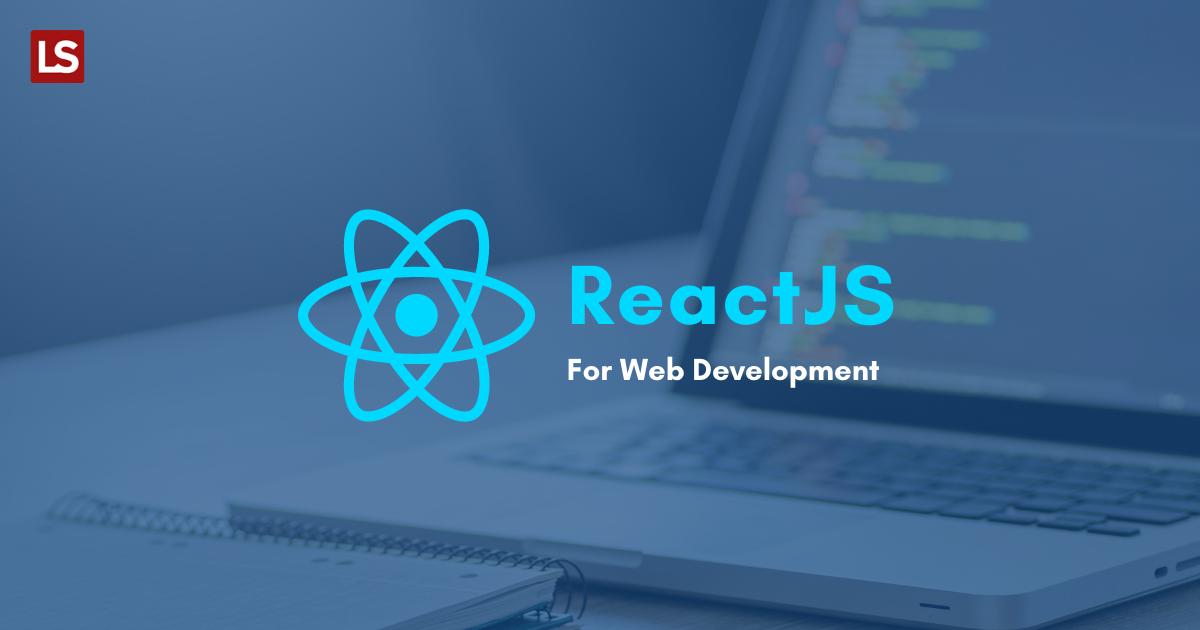As the first point of contact, front-end development is often considered the catalyst for uniquely conveying the brand image of any business to its potential users. However, that part of the web development process hasn’t evolved enough to reach any breakthrough, given the fair share of dynamic market size across the globe. But React actually begs to differ with a number of exceptions, being the most widely utilized web development technology so far in the market with 558,100 websites being developed which is continuously growing by 2.27% currently.
It is a JavaScript library mainly used for building user interfaces for single-page applications by dividing the user interface into composable elements. And perhaps the first name to break the trend of Angular, at least to some extent.
From the deployment on the news feed of Facebook back in 2011 and later on Instagram in 2012 by Jordan Walke, its first creator to demystifying the paradigm of front-end development, especially for building single-page application UI, has risen to fame primarily because of its super-rich features and ease of use.
The quote was taken from a long and exhaustive article by Douglas Crockford, “React Native Overview: Building Strong Mobile Apps with Native Web Technology.” React is one of those frameworks that are worthy of being a vast category in itself in translation. In some ways, it is like what Ruby on Rails is to web application development (think Bootstrap). At the same time, it can also be rendered on the server-side by Node and React Native for developing native apps.
Glimpse of a Simple React Component:
class HelloWorld extends React.Component {
render() {
return (
<div>
Hello world!
</div>
);
}
}
If you are interested in using React in your app or website, here are some reasons why you should and where you should use it. We’ll also show a couple of examples at the end of the post to help give you some ideas on how and where you should place it within your project.
About React
So let’s get one thing straight: React is not JavaScript MVC. It is component-based declarative programming. This is why you should use it in your web projects as well. React isn’t limited to web applications with a continuous introduction to newer experimental features such as concurrency and zero-bundle-size server components. It also has an impact on how you go about developing them.
- Reusable components.
- Doesn’t require separate files for logic and markup.
- Highly scalable and easily testable.
- Conditional statements in ReactJS are convenient.
- Allows for Immutability.
- Synergistic relationship with SEO.
- Its goal is to enable developers to build web and native apps adapting to the same technologies behind Facebook and Instagram.
- React has a fast learning curve for beginners.
- Modular and cohesive components.
- Open Source library with continued development.
- Declarative UI eases out the code readability and debugging.
- Stable dev community support and comprehensive developer’s toolkit.
- Efficient software delivery process by reducing time to market and solving most bugs from a single code base.
- Easily scalable for developing large-scale web & mobile apps.
- Calibrate to consolidate UI components into a single NPM shareable across multiple apps, consequently retaining the exact look & feel to all apps.
- Shareable library of in-house components.
- Simplified integration of other open source components.
- Can be converted from regular ReactJS web app into Progressive Web App with support tools.
What makes React stand out: Its features
Fast and Easiest Learning Curve
React has been through several debatable contexts with its contenders for its rich features, something which is often encountered in Angular vs. Reacts prolonging the much more than it should mostly because of its fast track and easy learning attracted by anyone looking forward to getting a reflexive exposure in the web development with a bare minimum understanding of HTML and JavaScript to kickstart the least learning leap. In contrast, around this central argument, just because React is made out of Facebook, that certainly doesn’t transcribe its great scalability of everything. React is certainly made by Facebook, but React is not at all Facebook possesses as a technology; otherwise, the same can also be considered in terms of Angular made by Google, .Net made by Microsoft, and Java made by Oracle.
It is undoubtedly that React is easier than other Javascript frameworks introducing newer terminologies every now and then, which isn’t actually the case with React as it incorporates everything already available. This made it grow in prominence amongst others to be the most popular JS library.
React has more flexibility and resilience evolved from Vanilla JavaScript with no structural enforcement like MVC or any other architectural pattern but was precisely syntactical. Development teams have full liberty to decide their style or patterns while working with an application. This enables vanilla JavaScript developers to experience component-based architecture without compromising their comfortability with vanilla JavaScript.
Which can perhaps result in a deconstructed app with various inadequacies such as naming conventions, haphazardous folder structures (if there are any), and redundant files that are stacked within the production deployment.
On paper, this could happen to be anything until you are not disciplined towards the more acceptable parts of the coding, which are not actually pertaining to coding, at least not directly.
Transitional Compatibility-React Native
Transitional penetration towards mobile-friendly ecosystems has been stiffly inclining according to the global web traffic reports generating over 50% in the last quarter of 2020 all alone from the smartphone user base, which indeed explains the potential demand of mobile-friendly web view that businesses are solemnly venturing towards for a quick shift.
React, which mostly appeared for web applications, however, offers enough flexibility and reusability additionally for being usable in developing native applications with the help of React Native, a custom renderer for React that uses native components over the web similar to React components as building blocks powerful. It is an open-source native library for mobile applications development that also serves access to the features of these platforms, besides transforming React code to be functional on iOS and Android.
As a result developing cross-platform apps for iOS & Android by reusing the same methodology & core architecture to offer products/services for upscaling the incoming business requirements through mobile app users.
You can write code and add components using Web APIs Localization Feature Overload. Here are the essential points to consider while deciding between React and React Native.
a) React more mainstream: You can find React applications in a plethora of different platforms like Chrome, Safari, Android Browser, iPhone, and Windows.
b) React Native is used mainly by Apple for iOS and Android.
c) React Native is much more mature: As per GitHub, React Native has been in the market for the last eight years. As per the figures from AppDynamics, React Native application market share in December 2016 alone was around 8.1%.
Simplified Supportability – JSX
Development of dynamic web apps used to be pretty complicated, especially if there is significant involvement of HTML strings & tags. However, React demystifies the entire process with less coding and additional functionality by introducing JSX.
JavaScript XML, in short JSX, is a JavaScript syntax extension more similar to HTML or XML syntax often used by the developers to easily create React components, accepting HTML quotes & tag syntax to render certain subcomponents. It is extended up to ECMAScript6 in order to establish the coexistence with JavaScript code.
While JSX isn’t mandatory but highly recommended to be used in ReactJS, which also promotes the supportability of building machine-readable codes and facilitating compound components in one compile-time verified file. In short, it is a markup syntax used to illustrate the UI appearance of an application and enabling the option of writing in TypeScript without having any native inclusion.
Facilitates To Develop Rich User Interfaces – Fast Render With Virtual DOM
This is feasible as the memory retainment of React is a virtual representation of a UI and synchronizes it with real DOM. Following this, React starts inferring the re-render time or ignoring specific pieces of DOM, apart from mitigating the performance cost of updating it.
- Immutable objects.
- React uses hooks introduced as a new feature.
- Use the JavaScript library.
- Handles state changes manually.
Dynamic Visibility Across Web
Businesses are primarily driven by SEO to not only retain their overall visibility across the web but also boost revenue organically. In contrast, it may sound pretty difficult to expect from JavaScript-backed web apps even though Google crawlers do render the web pages with JavaScript and index them along the way. Still, things are not usually the same when put into action. And that’s where React comes into perspective only for the usability of Server Side Rendering (SSR).
In a normal use case scenario, React renders in the web browser before the user even starts downloading all the required web elements from the browsed web apps, meaning it only renders the built-in .js file downloaded first to the web browser before the entire web page starts loading, which translates to Client-Side Rendering. And it is also a part of the reason why React web apps are super fast in nature. However, on the flip side of things, Client-Side Rendering of React web apps is also considered to be a major limitation due to the complexities in the crawlibilities.
But using React Server-Side Rendering (SSR), it can be rendered in the webpage on the server without running directly on the web browser using JavaScript code, even though it is first rendered from the server before sending to the user making the following webpages load directly, which not only reduces the web page loading time but also renders comparatively faster-preventing users to wait for react to run first in order to view the results. And thus serving the purpose of SEO by allowing full crawlability of the entire web page content without the need for Google running JavaScript in order to do the same.
In a nutshell, ReactJS allows JavaScript sites to crawl like an HTML page.
Besides, React web apps can be made SEO-friendly by implementing a layer of Next.js, to make SPAs render at the server-side.
Enable quick and better control over the web/app with One-way Data Binding
It is more like a series of nested components, where data is passed to a child component from a parent component and the process of data flow through the entire application becomes possible only in one direction. Although developers cannot directly edit any component in between, so the parent component passes one of its own functions as a callback in a property when calling the child component. The child component can then provide the new value to the data as per the user’s action without updating the actual data.
However, additional requirements are also needed if the flow of data is in different directions as the data can’t be changed due to its immutable components. And that’s where Flux is introduced as a pattern for UI which runs on a unidirectional data flow. It is a JavaScript application architecture that not only boosts the flexibility and efficiency of the application but also helps developers to get complete control over the web or native apps, which eventually becomes easier in debugging.
Event-Driven
The Demand And Job Market Of React Technology
GitHub Stars is a new site that tracks the popularity of software libraries/frameworks. As of today, react was second only to vue.js for JavaScript libraries/frameworks. At the time of this writing, react has 83,851 stars on GitHub, while angular 2 has 68,904. So while Angular 2 might be more popular with developers and business owners, it’s not as popular with software developers as react is.
React is on fire in the tech and startup world. It’s all over websites, ads, social media walls, and you name it. As per TIOBE, React is the second most popular JS library and trending with a bullet. In simple words, its demand is high. Hence companies will be on the lookout for React developers.
Where should you use react technology?
- Question and answers or trivia websites
- E-commerce
- Social networking websites
- Business websites
- Dashboards
NPM Trends
At the time of writing, this React has surpassed the 10 million mark with a steep incline in the stats followed by having 4x more downloads than its neighboring rival, Vue.js.
Most loved JavaScript of all time
A quick recap on React technology
The world of JS apps is rapidly changing every day with the introduction of newer frameworks or libraries. The users are becoming more and more interested in what can be done with them. All we can say is that React is one of the most innovative and revolutionary technologies in the industry. It has already proved to be a game-changer including Great UI/UX, Cost-efficient, SEO-friendly, Supports Scalability & Quick Development as some of its strong pros along with additional features of mobile-friendly, extensive developer community support and without any mandatory involvement of starting structure, unlike Angular, where a CLI is mostly required in order to generate the necessary setup for the framework, React takes away all of that with minimal effort. It brings the liberty of incorporating third-party tools & easy tricks to optimize your web app performance as an open-source framework.
While as we speak, React is rapidly evolving with new features like React suspense for better rendering, React Fiber for better concurrency, React hooks to manage functional components with less boilerplate code, etc. This is not the only reason, but we firmly believe that if you are building digital products, React is the only way to go. If this is your question: should you start building an app in React? The answer is definitely yes to go ahead.




